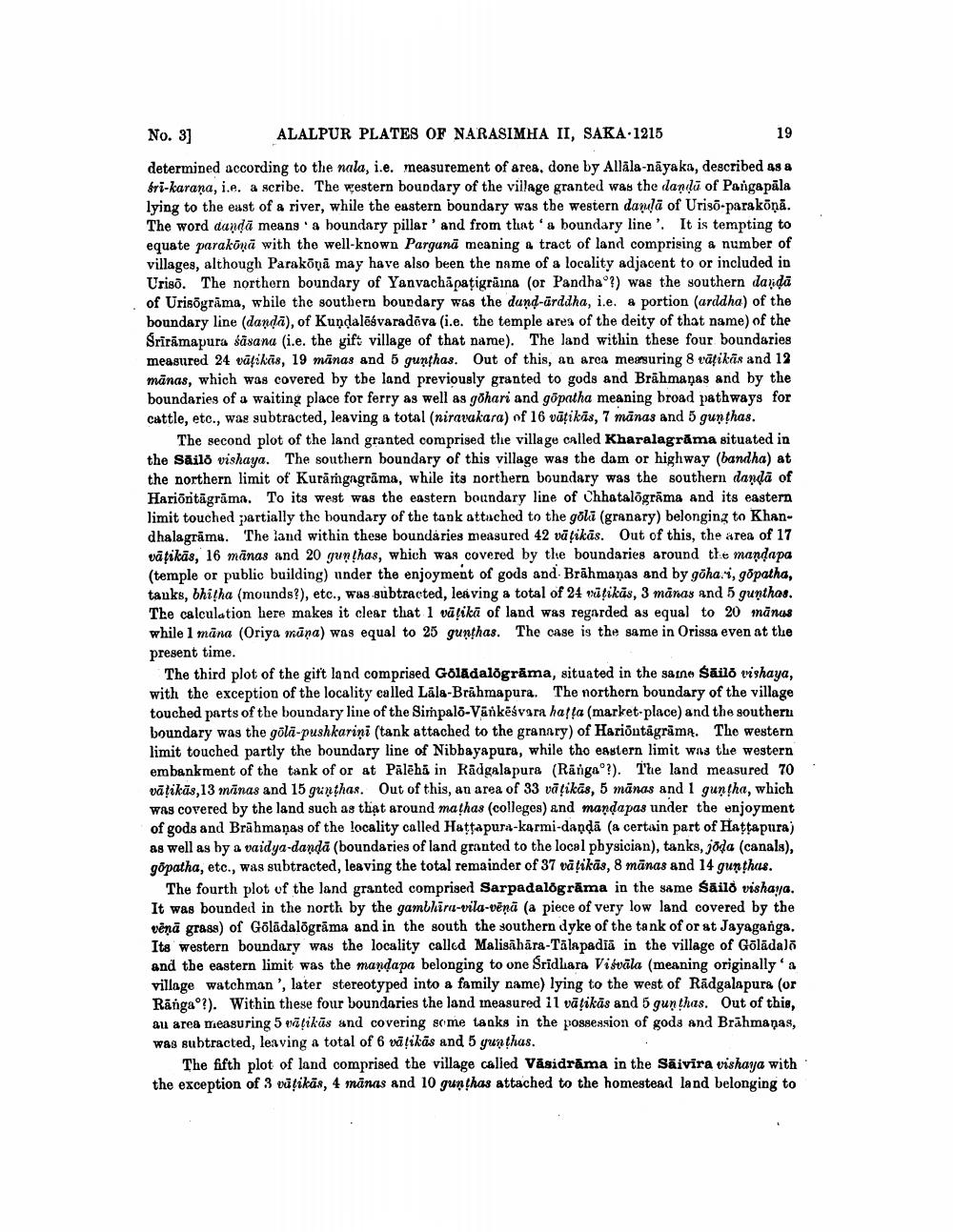________________
19
No. 3]
ALALPUR PLATES OF NARASIMHA II, SAKA 1215 determined according to the nala, i.e. measurement of area, done by Alläla-näyaka, described as a bri-karana, i.e. a scribe. The western boundary of the village granted was the dandü of Pangapāla lying to the east of a river, while the eastern boundary was the western danılā of Uriső-paraköņā. The word dandā meang'a boundary pillar' and from that a boundary line'. It is tempting to equate parakānā with the well-known Pargunā meaning & tract of land comprising a number of villages, although Parakõnā may have also been the name of a locality adjacent to or included in Uriso. The northern boundary of Yanvachapatigrāina (or Pandha°?) was the southern dandā of Urisõgrāma, while the southern boundary was the dund-ārddha, i.e. a portion (arddha) of the boundary line (danda), of Kundalēsvaradova (i.e. the temple area of the deity of that name) of the Srīrāmapura sāsana (i.e. the gift village of that name). The land within these four boundaries measured 24 vāfikas, 19 mänas and 5 gunthas. Out of this, an area measuring 8 vātikās and 12 mānas, which was covered by the land previously granted to gods and Brähmaņas and by the boundaries of a waiting place for ferry as well as gohari and gopatha meaning broad pathways for cattle, etc., was subtracted, leaving a total (niravakara) of 16 vātikās, 7 månas and 5 gunthas.
The second plot of the land granted comprised the village called Kharalagrăma situated in the Sailo vishaya. The southern boundary of this village was the dam or highway (bandha) at the northern limit of Kurangngrāma, while its northern boundary was the southern dandā of Hariöntāgrāma. To its west was the eastern boundary line of Chhatalögrāma and its eastern limit touched partially the boundary of the tank attached to the gola (granary) belonging to Khandhalagrāma. The land within these boundaries measured 42 vāçikās. Out of this, the area of 17 vātikās, 16 manas and 20 gun!has, which was covered by the boundaries around the mandapa (temple or public building) under the enjoyment of gods and Brāhmaṇas and by göha. i, gópatha, tanks, bhitha (mounds?), etc., was subtracted, leaving a total of 24 vüţikās, 3 manas and 5 gunthas. The calculation here makes it clear that 1 vāļikā of land was regarded as equal to 20 mānas while 1 māna (Oriya mūna) was equal to 25 gunthas. The case is the same in Orissa even at the present time.
The third plot of the gift land comprised Goladalögrāma, situated in the sanne Sailo vishaya, with the exception of the locality called Lāla-Brāhmapura. The northern boundary of the village touched parts of the boundary line of the Simpalo-Vänkëśvara hafla (market-place) and the southeru boundary was the golā-pushkarini (tank attached to the granary) of Hariðntāgrāma. The western limit touched partly the boundary line of Nibbayapura, while tho eastern limit was the western embankment of the tank of or at Palēhi in Radgalapura (Rangao?). The land measured 70 vāļikās, 13 mūnas and 15 gunthas. Out of this, an area of 33 vāļikās, 5 mānas and 1 guntha, which was covered by the land such as that around mathas (colleges) and mandapas under the enjoyment of gods and Brāhmaṇas of the locality called Hattapura-karmi-daņdā (a certain part of Hattapura) as well as by a vaidya-dandā (boundaries of land granted to the local physician), tanks, jõda (canals), gõpatha, etc., was subtracted, leaving the total remainder of 37 vā tikās, 8 mānas and 14 gunthus.
The fourth plot of the land granted comprised Sarpadalögrāma in the same śāild vishaya. It was bounded in the north by the gambhira-vila-vēnā (a piece of very low land covered by the vēnā grass) of Gölādalögrāma and in the south the southern dyke of the tank of or at Jayaganga. Its western boundary was the locality called Malisāhāra-Tālapadia in the village of Gõlādali and the eastern limit was the mandapa belonging to one Sridhara Visvāla (meaning originally a village watchman, later stereotyped into a family name) lying to the west of Radgalapura (or Rangao?). Within these four boundaries the land measured il vāçikās and 5 gunthas. Out of this, au area measuring 5 ovāçikūs and covering some tanks in the possession of gods and Brāhmaṇas, was subtracted, leaving a total of 6 välikäs and 5 yun thus.
The fifth plot of land comprised the village called Väsidrāma in the Sāivira vishaya with the exception of 3 vātikās, 4 manas and 10 gunthas attached to the homestead land belonging to




